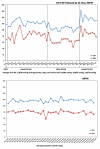Role of Ambulatory and Home Blood Pressure Monitoring in Clinical Practice: A Narrative Review
- PMID: 26457954
- PMCID: PMC4638406
- DOI: 10.7326/M15-1270
Role of Ambulatory and Home Blood Pressure Monitoring in Clinical Practice: A Narrative Review
Abstract
Hypertension, a common risk factor for cardiovascular disease, is usually diagnosed and treated based on blood pressure readings obtained in the clinic setting. Blood pressure may differ considerably when measured inside versus outside of the clinic setting. Over the past several decades, evidence has accumulated on the following 2 approaches for measuring blood pressure outside of the clinic: ambulatory blood pressure monitoring (ABPM) and home blood pressure monitoring (HBPM). Both of these methods have a stronger association with cardiovascular disease outcomes than clinic blood pressure measurement. Controversy exists about whether ABPM or HBPM is superior for estimating risk for cardiovascular disease and under what circumstances these methods should be used in clinical practice for assessing blood pressure outside of the clinic. This review describes ABPM and HBPM procedures, the blood pressure phenotypic measurements that can be ascertained, and the evidence that supports the use of each approach to measuring blood pressure outside of the clinic. It also describes barriers to the successful implementation of ABPM and HBPM in clinical practice, proposes core competencies for the conduct of these procedures, and highlights important areas for future research.
Figures

References
-
- Pickering TG, Hall JE, Appel LJ, Falkner BE, Graves J, Hill MN, et al. Recommendations for blood pressure measurement in humans and experimental animals: part 1: blood pressure measurement in humans: a statement for professionals from the Subcommittee of Professional and Public Education of the American Heart Association Council on High Blood Pressure Research. Circulation. 2005;111(5):697–716. - PubMed
-
- Mancia G, Fagard R, Narkiewicz K, Redon J, Zanchetti A, Bohm M, et al. 2013 ESH/ESC guidelines for the management of arterial hypertension: the Task Force for the Management of Arterial Hypertension of the European Society of Hypertension (ESH) and of the European Society of Cardiology (ESC) Eur Heart J. 2013;34(28):2159–219. - PubMed
-
- Pickering TG, Shimbo D, Haas D. Ambulatory blood-pressure monitoring. N Engl J Med. 2006;354(22):2368–74. - PubMed
-
- O'Brien E, Parati G, Stergiou G, Asmar R, Beilin L, Bilo G, et al. European Society of Hypertension position paper on ambulatory blood pressure monitoring. J Hypertens. 2013;31(9):1731–68. - PubMed
-
- Pickering TG, Miller NH, Ogedegbe G, Krakoff LR, Artinian NT, Goff D, et al. Call to action on use and reimbursement for home blood pressure monitoring: a joint scientific statement from the American Heart Association, American Society Of Hypertension, and Preventive Cardiovascular Nurses Association. Hypertension. 2008;52(1):10–29. - PMC - PubMed
Publication types
MeSH terms
Grants and funding
LinkOut - more resources
Full Text Sources
Other Literature Sources
Medical
Miscellaneous
